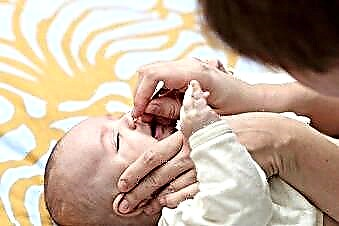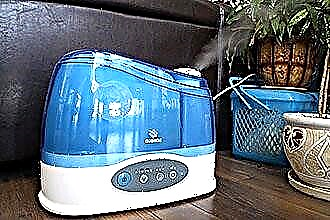A runny nose is an unpleasant symptom, signaling the development of inflammatory processes in the nasopharynx. The appearance of mucopurulent discharge in newborns is associated with the multiplication of viral or bacterial pathogens in the upper respiratory tract. Frequent morbidity in infants is due to reduced body resistance and the lack of acquired immunity.
 Can breast milk be used for a cold in babies?
Can breast milk be used for a cold in babies?
Many young parents believe that mother's milk has antibacterial and anti-inflammatory properties.
Therefore, it can be used as nasal drops to eliminate mucous secretions in the nasal passages in newborns. What is the opinion of experts on this matter?
Breast milk composition
Milk is a source of a large amount of nutrients necessary for the normal development of an infant. It contains vitamins, minerals and organic acids to help strengthen the immune system of the newborn. The main components that make up milk include:
- proteins - casein and whey proteins contribute to the intensive development of bone and muscle tissue;
- lactose - the main source of carbohydrates, which takes part in the normalization of the central nervous system;
- fatty acids - have a beneficial effect on the digestive tract and increase the reactivity of the body;
- vitamins - take part in many biochemical processes, which helps to strengthen general and local immunity;
- micro and macro elements - contribute to the normal development of the skeleton and muscles;
- antibodies - prevent the penetration of microbes and viruses into the body, entailing the development of acute respiratory infections.
Human milk is a balanced, easily digestible product that surpasses cow's milk and infant formula in terms of its usefulness.
Milk and runny nose
 Can breast milk be buried in the nose? According to some traditional healers, breast milk is a versatile antiviral and antibacterial agent that can be used as a cure for rhinitis. But is it really so?
Can breast milk be buried in the nose? According to some traditional healers, breast milk is a versatile antiviral and antibacterial agent that can be used as a cure for rhinitis. But is it really so?
The composition of the nutrient fluid contains antibodies, which form the immunity of the newborn. However, the medicinal properties of the product appear only when its main components are found in the child's blood. Experts warn that antibodies are not absorbed into the body through the mucous membranes of the ENT organs, therefore, they do not contribute to the elimination of pathogenic flora in the foci of inflammation.
Burying breast milk in the nose with a runny nose can only harm the newborn.
The product contains proteins that are a favorable environment for the development of pathogenic microbes. Inappropriate use of milk can cause a bacterial infection to join ARVI, which is fraught with the formation of abscesses in the nasopharyngeal mucosa and the development of sinusitis.
Dangers of using milk
Why shouldn't breast milk be put into a newborn's nose? The antimicrobial and anti-inflammatory properties of the product only appear when taken orally. Using it as medicinal drops can be not only useless, but also dangerous, due to the following reasons:
- after instillation of the product, crusts form in the nasal passages, which interfere with normal breathing through the nose;
- ineffective therapy for colds can cause the development of bronchitis, sinusitis and pneumonia;
- the product contains lactose, which is an ideal substrate for the development of aerobic bacteria.
Talk to your pediatrician before dripping breast milk into your nose. Many parents are sure that a natural product is no less dangerous to the health of a child than synthetic nasal drops. In fact, drugs that contain toxic substances are not used to treat rhinitis in infants. As a rule, children's drugs for the common cold are made on the basis of saline or sea salt, which has anti-inflammatory properties.
Important! Do not use vasoconstrictor drops to treat a newborn without the recommendation of a specialist.
Possible complications
Most pediatricians and otolaryngologists are sure that it is absolutely impossible to instill breast milk into the nose of an infant. In the case of oral use, the product helps to increase immunity, which reduces the risk of developing colds. At the same time, do not forget that a woman can be a carrier of pathogenic bacteria and viruses, which in a child's body will provoke the development of the disease. The most common ones include:
- Staphylococcus aureus is a gram-positive bacterium, which, when it enters the child's body, leads to damage to internal organs and the formation of abscesses on the skin. Staphylococcal infections are resistant to the effects of antimicrobial agents, which reduces the effectiveness of antibiotic therapy. Untimely elimination of the infection can cause the development of otitis media, pneumonia, cardiovascular diseases, etc.;
- Klebsiella is a gram-negative anaerobic bacterium, the development of which is fraught with damage to the gastrointestinal tract, genitourinary system, upper respiratory tract and brain. The active development of the bacterial environment in the child's body becomes the cause of pneumonia, sepsis, rhinoscleroma, tracheitis, enterocolitis, cystitis, etc.;
- Candida mushrooms - yeast-like fungus,
 related to the number of opportunistic microorganisms. The reproduction of the fungus in the child's body leads to the appearance of a white plaque on the mucous membranes, which indicates the development of thrush.
related to the number of opportunistic microorganisms. The reproduction of the fungus in the child's body leads to the appearance of a white plaque on the mucous membranes, which indicates the development of thrush.
To prevent complications, if a newborn has a runny nose, seek help from a pediatrician. After examination and testing, the specialist will be able to determine the type of pathogens that provoked inflammation, which will facilitate the choice of the optimal course of treatment.
Baby nasal drops
Breast milk from a common cold in newborns can be replaced with nasal drops, which have a pronounced anti-inflammatory effect. In the framework of pediatric therapy, preparations based on sea salt, plant extracts and isotonic water are used to eliminate rhinitis. They do not dry out the mucous epithelium, but help to eliminate secretions that interfere with normal nasal breathing.
To relieve the symptoms of a cold, experts recommend using the following types of nasal drops:
- moisturizers - safe drugs that contribute to the regression of inflammatory processes in the ciliated epithelium. They are not addictive, so they can be used up to 10 times a day for a half month;
- vasoconstrictor - drops of symptomatic action, which help to reduce swelling of the nasopharynx, as a result of which nasal breathing is facilitated. They contain components that, in case of an overdose, can provoke complications, therefore they are used in extreme cases for the treatment of children from 3-4 months;
- immunomodulatory - drugs, which include components that enhance local immunity. They are used to eliminate rhinovirus infections in children under the age of 1 year;
- antibacterial - drugs that include antibiotics that inhibit the development of gram-positive and gram-negative microbes. They are used exclusively for the treatment of complicated colds due to their toxic effect.
Oil solutions such as "Pinosola" are undesirable to use in the treatment of newborns, which is due to the high risk of developing an allergic reaction to the components of the drug.
Overview of nasal drops
 Late treatment of rhinitis in infants is often the cause of complications.
Late treatment of rhinitis in infants is often the cause of complications.
Children are not able to blow their nose on their own and clear the nasal passages of mucus, which, when the child is horizontally positioned along the back of the throat, can penetrate into the digestive tract.
Ineffective treatment of the common cold leads to the development of sinusitis, tonsillitis, pneumonia and other complications.
To eliminate inflammatory processes in the nasopharynx in newborns, the following types of nasal drops can be used:
- "Nazol Baby" - vasoconstrictor drops, which contribute to the rapid elimination of puffiness in the nasal mucosa; cannot be used in pediatric therapy for more than 3-4 days;
- "Genferon-Light" - an immunomodulatory drug based on interferon, which helps to increase immunity and eliminate viral pathogens in the foci of inflammation;
- Otrivin Baby is an antiphlogistic drug based on xylometazoline hydrochloride; can be used to treat children from 3 months;
- "Aqua Maris" - sterilized sea water, which helps to eliminate inflammation and moisturize the nasal mucosa;
- "Aqualor" is a preparation based on sea water, which does not contain preservatives; has a pronounced antiviral, decongestant and wound healing effect.
Before using the drops, the nasal passages of the newborn must be cleared of accumulated mucus.
After instilling the drug, the child must be tilted forward slightly to prevent the solution from entering the oropharynx.

 related to the number of opportunistic microorganisms. The reproduction of the fungus in the child's body leads to the appearance of a white plaque on the mucous membranes, which indicates the development of thrush.
related to the number of opportunistic microorganisms. The reproduction of the fungus in the child's body leads to the appearance of a white plaque on the mucous membranes, which indicates the development of thrush.

